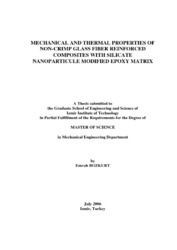Please use this identifier to cite or link to this item:
https://hdl.handle.net/11147/3642Full metadata record
| DC Field | Value | Language |
|---|---|---|
| dc.contributor.advisor | Tanoğlu, Metin | en |
| dc.contributor.author | Bozkurt, Emrah | - |
| dc.date.accessioned | 2014-07-22T13:52:00Z | - |
| dc.date.available | 2014-07-22T13:52:00Z | - |
| dc.date.issued | 2006 | en |
| dc.identifier.uri | http://hdl.handle.net/11147/3642 | - |
| dc.description | Thesis (Master)--Izmir Institute of Technology, Mechanical Engineering, Izmir, 2006 | en |
| dc.description | Includes bibliographical references (leaves: 75-79) | en |
| dc.description | Text in English; Abstract: Turkish and English | en |
| dc.description | xii, 79 leaves | en |
| dc.description.abstract | In the present study, epoxy based nanocomposites were prepared with modified and unmodified silicate nanoparticules to apply as a matrix resin for non-crimp glass fiber reinforced polymer composites. The effects of the silicate nanoparticules on the mechanical, thermal and flame retardancy properties of glass reinforced composites were investigated. Laminates were manufactured with hand lay-up technique and cured under compression. To intercalate the layers and obtain better dispersion of silicate layers within the matrix, silicate (montmorillonite, MMT) particules were treated with hexadecyltrimethylammonium chloride (HTAC) surfactants. X-ray diffraction of silicates with and without surface treatment indicated that intergallery spacing of layered silicate increased with surface treatment. Tensile tests showed that silicate loading had minor effect on the tensile strength and modulus of the composite laminates. Flexural properties of laminates were improved with the addition of silicate due to the improved interface between glass fibers and epoxy matrix. With the addition of modified MMT (OMMT), interlaminar shear strength (ILSS) of laminates decreased slightly but fracture toughness (KIC) of laminates were increased. The fracture surfaces were examined with scanning electron microscopy (SEM) and the results revealed that fracture mechanisms were altered due to the presence of silicates in the matrix. Differential scanning calorimetry (DSC) results showed that modified silicate particules increase the glass transition temperatures (Tg) of composite laminates. Incorporation of OMMT particules increased the dynamic mechanical properties of non-crimp glass fiber reinforced epoxy composites. It was found that the flame resistance of composites was improved due to silicate particule additions into the epoxy matrix. | en |
| dc.language.iso | en | en_US |
| dc.publisher | Izmir Institute of Technology | en |
| dc.rights | info:eu-repo/semantics/openAccess | en_US |
| dc.subject.lcc | TA418.9.C6 .B79 2006 | en |
| dc.subject.lcsh | Polymeric composites | en |
| dc.subject.lcsh | Polymeric composites--Mechanical properties | en |
| dc.subject.lcsh | Reinforced concrete, Fiber | en |
| dc.title | Mechanical and thermal properties of non-crimp glass fiber reinforced composites with silicate nanoparticule modified epoxy matrix | en_US |
| dc.type | Master Thesis | en_US |
| dc.institutionauthor | Bozkurt, Emrah | - |
| dc.department | Thesis (Master)--İzmir Institute of Technology, Mechanical Engineering | en_US |
| dc.relation.publicationcategory | Tez | en_US |
| item.grantfulltext | open | - |
| item.openairecristype | http://purl.org/coar/resource_type/c_18cf | - |
| item.cerifentitytype | Publications | - |
| item.openairetype | Master Thesis | - |
| item.languageiso639-1 | en | - |
| item.fulltext | With Fulltext | - |
| Appears in Collections: | Master Degree / Yüksek Lisans Tezleri | |
Files in This Item:
| File | Description | Size | Format | |
|---|---|---|---|---|
| T000517.pdf | MasterThesis | 18.3 MB | Adobe PDF |  View/Open |
CORE Recommender
Page view(s)
106
checked on Apr 22, 2024
Download(s)
116
checked on Apr 22, 2024
Google ScholarTM
Check
Items in GCRIS Repository are protected by copyright, with all rights reserved, unless otherwise indicated.